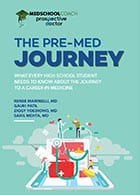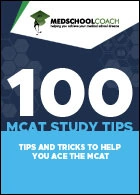
Table of Contents
16 Trending Topics for Pre-Med Interviews (Fall 2025)
Getting ready for your medical school interviews? Attractive candidates are familiar with what’s happening in the medical field, even before seeing a patient for the first time.
Below, I outline the topics your AdComs will most likely want to discuss. To make the most of these stories and emerging research, remember that, for any part of the medical school application process, you should consider them in the context of:
- Ethical decision making (like you’ll discuss on situational judgment tests like Casper or AAMC PREview)
- Patient care and communication
- Research (especially if you’re doing an MD/PhD track or plan on applying to research-heavy institutions)
We work with several thousand students every single year to ensure they’re prepared and confident for each medical school interview. Learn how you can benefit from expert Physician Advisors, most of whom are former AdComs with firsthand experience.
AI in Healthcare
1. Generative AI Enters Clinical Workflows
Tech giants are bringing artificial intelligence into health records – for example, Microsoft and Epic Systems announced an integration of OpenAI’s GPT-4 into Epic’s electronic health record platform. This allows tools like automatic drafting of clinician responses and conversational data analysis in the EHR.
These efforts aim to reduce admin burdens on doctors, and an AMA survey indicates growing adoption. By late 2024, about 66% of physicians were using some form of AI in practice (up from 38% the year before).
But there’s still a lot of room to grow, and adoption is likely to slow down. Physicians remain cautious due to concerns about privacy, errors, and liability, even as enthusiasm for AI’s assistive potential slowly grows.
Reproductive Health & Policy
2. Abortion Bans Impact Medical Training
The aftermath of the 2022 Dobbs decision overturning Roe v. Wade is reshaping medical education. New AAMC data show that two years later, fewer medical graduates are applying to residencies in states with stricter abortion restrictions, while applications to states without such restrictions have declined much less.
In the 2023-24 cycle, states with the most restrictive abortion laws — effectively banning most abortions — saw a 4.2% drop in U.S. MD residency applicants versus only 0.6% in states where abortion remained legal. Many students cite concerns about being unable to train in full-spectrum OB/GYN care and are avoiding programs in states with restricted reproductive care.
A note for med school interviewees: Reproductive healthcare has been a topic of considerable discussion in the medical community for several decades. Understanding the relevant questions that may come up in interviews is a must-do for any prospective physician.
3. First OTC Birth Control Pill
In July 2023, the FDA approved Opill (norgestrel) as the first over-the-counter daily oral contraceptive in the United States. This progestin-only birth control pill will be available without a prescription to users of all ages, a landmark move to expand contraceptive access.
Health experts note that making a safe, effective birth control pill available OTC could reduce unplanned pregnancies by removing barriers for those unable to get a doctor’s prescription. Medical and public health organizations widely hailed the decision as a victory for reproductive health access.
Public Health & Policy
4. Millions Losing Medicaid Coverage
After the COVID-19 public health emergency protections ended in 2023, states resumed verifying Medicaid eligibility, resulting in what’s been called the largest Medicaid coverage purge in U.S. history.
By late 2023, over 10 million people had been disenrolled from Medicaid, and about 7 in 10 of those lost coverage for procedural or paperwork reasons (not because they were truly ineligible). This “unwinding” process has exposed significant gaps in state systems and prompted federal warnings, as many low-income children and adults abruptly became uninsured.
Efforts are ongoing to improve outreach and streamline renewals to prevent eligible people from falling through the cracks.
Furthermore, congressional bills proposed in summer 2025 could lead to an additional 12-20 million people losing access to Medicaid, adding further complication to an existing issue.
5. Climate Change and Health Emergencies
2023 brought extreme weather that underscored climate change’s impact on health. A summer of record heat waves led to a spike in heat-related illnesses and deaths. An AP analysis found more than 2,300 U.S. deaths linked to extreme heat in summer 2023, the highest in at least 45 years.
At the same time, massive Canadian wildfire smoke drifted over the U.S. Midwest and East Coast in June 2023, sending air quality to “hazardous” levels in many cities. Health officials warned residents to stay indoors as the smoke caused respiratory issues, highlighting the need for better emergency preparedness for climate-driven events.
These experiences have accelerated public health planning around heat action plans, clean air shelters, and other adaptations, and as such, climate-related health threats have become more frequent.
Healthcare Equity & Ethics
6. Maternal Mortality Disparities in the U.S.
The U.S. maternal mortality rate – already the worst among high-income countries – showed some improvement overall in 2023, dropping to 18.6 deaths per 100,000 live births (down from 22.3 in 2022). However, racial disparities remain staggering.
The maternal death rate for Black American women was 50.3 per 100,000 in 2023, which is over three times higher than the rate for White women (14.5). Black mothers in the U.S. face disproportionately high risks due to factors ranging from inequities in access and quality of care to underlying chronic conditions and structural racism.
Reducing this gap has become an urgent focus of public health, spurring initiatives from expanded Medicaid postpartum coverage to bias training and community-based maternal health programs.
Read Next: Your Guide to Multiple Mini Interviews (Plus Sample Questions & Prep)
7. Restrictions on Gender-Affirming Care
Access to healthcare for transgender youth has become a flashpoint. As of mid-2025, 27 U.S. states have passed laws banning or limiting gender-affirming medical care for minors – typically prohibiting treatments like puberty blockers or hormone therapy, even with parental consent.
Many major medical organizations (AMA, AAP, Endocrine Society, and others) oppose these bans. They note that evidence shows transgender youth allowed to receive gender-affirming care may have much better mental health outcomes (including significantly lower rates of depression, anxiety, and suicidal ideation) than those denied such care.
Nonetheless, a June 2025 Supreme Court decision upheld one state’s ban, making it harder to challenge these laws. This ongoing ethical and legal battle has real human impacts, as many families with trans adolescents now face choices to move to other states or find alternative ways to get care.
Biomedical & Clinical Breakthroughs
8. New Drugs for Alzheimer’s Show Promise
After decades of failures in Alzheimer’s disease, 2023–2024 brought tangible progress with disease-modifying therapies. FDA fully approved Leqembi (lecanemab) in July 2023 and Kisunla (donanemab) in July 2024 – both antibodies that target brain amyloid plaques.
Donanemab was shown to significantly slow cognitive decline in early Alzheimer’s patients by roughly 25-35% relative to placebo over 18 months. Patients on these drugs decline more slowly in memory and daily function, offering families additional months of independent living.
However, the drugs only help in early-stage disease and come with risks like brain swelling/bleeds (amyloid-related imaging abnormalities). They also carry six-figure annual price tags, raising debates about Medicare coverage and equitable access.
Even so, these approvals mark the first real treatments targeting Alzheimer’s underlying pathology rather than just its symptoms.
9. Weight-Loss Drugs Improve Heart Health
So-called “GLP-1” medications for obesity – such as semaglutide (Wegovy) and tirzepatide – continued to make headlines. These drugs, initially used for diabetes, help patients achieve dramatic weight loss (15% or more of body weight on average). In 2023, we learned they may also cut the risk of severe heart problems.
The SELECT trial (presented in late 2023) showed that a weekly 2.4mg semaglutide injection led to a 20% reduction in heart attacks, strokes, or cardiovascular deaths in overweight/obese people with known heart disease. Following this, the FDA expanded semaglutide’s indication in early 2024 so that treating obesity is explicitly intended to reduce cardiovascular risk.
With over 70% of American adults overweight or obese, these findings have been called a “game-changer,” – suggesting aggressive obesity treatment is a new frontier in preventing heart disease. Demand for the medications has skyrocketed, although high costs and access issues (insurance coverage, supply shortages) remain challenges.
10. Synthetic Human Embryo Models Spur Ethical Debate
In June 2023, scientists announced they had created human embryo-like structures from stem cells — without using sperm, eggs, or a uterus. An Israeli team at the Weizmann Institute grew a stem-cell-based model resembling a 14-day-old human embryo, complete with the beginnings of internal structures.
These lab-made embryo models, sometimes called “synthetic embryos” (though they cannot develop into a baby), offer researchers a novel window into early human development and disease. They could help researchers study miscarriage, infertility, and the effects of drugs in pregnancy.
However, this breakthrough raises big ethical and regulatory questions: When should these models be considered an “embryo” with legal and moral status? Current guidelines prohibit growing human embryos (even models) beyond 14 days, and regulators are rushing to keep up with the science.
This emerging technology may force new rules as we balance scientific insight against ethical boundaries.
Healthcare Delivery & Workforce
11. Record Healthcare Worker Strike at Kaiser
In October 2023, over 75,000 workers at Kaiser Permanente launched the largest healthcare strike in U.S. history. Nurses, medical assistants, technicians, and other staff across multiple states walked out for three days, protesting severe understaffing, burnout, and wage issues.
The unions argued that chronic personnel shortages (worsened by the pandemic) have led to unsafe conditions and exhausting workloads. They pointed out that Kaiser had billions in profits while staff were “burnt out and fed up”.
The strike ended after Kaiser agreed to a deal including historic wage increases (up to 21% over four years) and commitments to address staffing levels. This labor unrest at a primary health system highlights broader workforce challenges in healthcare, as hospitals nationwide face nursing shortages, clinician burnout, and unionization efforts.
Ensuring a robust and satisfied healthcare workforce has become a pressing concern for system leaders and policymakers alike.
12. Big Tech & Retail Disrupting Primary Care
2023 saw non-traditional players expanding their footprint in healthcare delivery. Amazon completed its $3.9 billion acquisition of One Medical, a nationwide primary care group, in February 2023.
One Medical offers membership-based, tech-enabled primary care (with 24/7 virtual visits and same-day appointments). Amazon is leveraging this to offer health services integrated with its Prime membership and in partnerships with health systems.
At the same time, other retail giants made moves: CVS Health acquired and integrated physician practices, Walgreens invested in primary and urgent care clinics (though it has faced recent setbacks), and Walmart explored new clinic models.
The push by retail and tech companies aims to make accessing basic healthcare as convenient as shopping – via clinics in stores or telehealth apps – and could reshape how Americans get their care.
Observers note challenges (thin profit margins and quality concerns have stalled some efforts). Still, the trend of “retail healthcare” is accelerating, promising more options for consumers outside the traditional doctor’s office setting.
Government Policy & Institutional Challenges
13. Increased Governmental Skepticism of Vaccines
ACIP Purge & COVID‑19/Flu Vaccine Policy Changes: In June 2025, HHS Secretary RFK Jr. dismissed all 17 members of the CDC’s Advisory Committee on Immunization Practices (ACIP) and replaced them with vaccine-skeptical appointees.
He also ended federal recommendations for COVID‑19 vaccines in healthy children and pregnant individuals and banned flu shots containing thimerosal. Top CDC experts, including Fiona Havers and Lakshmi Panagiotakopoulos, resigned in protest, citing erosion of evidence-based policy.
A lawsuit filed by the American Academy of Pediatrics and other medical groups challenges the May 2025 “Secretarial Directive” that removed COVID‑19 vaccines from the immunization schedule for children and pregnant individuals.
Doctors report rising patient mistrust and misinformation in pediatric clinics, complicating routine care.
14. Challenges for Emergency Departments Nationwide
Several factors in recent years have led to remarkable stress on emergency departments in hospitals throughout the U.S. Some of the most significant include:
- Unfilled Residencies & Workforce Stress: Emergency medicine (EM) saw significant residency match disruptions: 555 positions went unfilled in 2023 (up from 219 in 2022), and applicants cited concerns about job security, burnout, COVID-19 stress, and healthcare corporatization. Many EM residencies remain unfilled, notably in smaller or corporate-owned programs, exacerbating staffing challenges.
- Overcrowding & ED Strain: EDs face chronic overcrowding, leading to delayed care. A 2025 study describes an AI model that predicts waiting room volume six hours ahead, aimed at improving staffing and resource planning.
- Mental Health & System Pressures: Emergency staff continue to endure high burnout, workplace violence, and moral injury, highlighted by the Lorna Breen tragedy and ongoing mental health initiatives like the Lorna Breen Act.
Impacts ripple into broader care systems as EDs increasingly become the safety net for untreated mental health and primary care needs.
15. Federal Restrictions on Foreign Medical Students (FMGs) and Foreign‑Trained Physicians
Due to stricter immigration rules, FMGs face challenges securing J‑1 waivers, H‑1B visas, and bypassing U.S. residency requirements, even though many states now ease licensing for foreign-trained physicians in rural shortage areas.
The demand for IMGs, especially in rural and underserved areas, threatens to worsen physician shortages. Policy experts note that easing credential and visa barriers is an urgent, bipartisan priority to address this gap.
Econometric studies link migration policy to rural physician distribution, showing that loosening restrictions improves rural healthcare access. Limiting FMGs through visa/law changes could intensify doctor shortages, especially in small towns and rural settings already struggling to attract U.S.-trained physicians.
16. Cutting of NIH/Research Grant Funding & Downstream Impacts
As of July 3, more than 4,400 NIH grants—totaling over $10.1 billion—were cut or at risk, including 2,834 research awards, which affected fellowships and early‑career scientists. Analysts estimate that every NIH dollar yields ~$2.56 in economic activity – the current cuts could result in ~$16 billion in financial losses and 68,000 jobs lost.
A JAMA forum described the funding reductions as a “$8 trillion health care catastrophe,” warning of long-term setbacks in biomedical science, cancer and rare disease research, and translational innovation.
Early-career researchers face canceled grants, halted trials, hiring freezes, and “career pathway collapse,” driving talent abroad (to Europe, Canada, etc.) and risking a “lost generation” of scientists.
Sources: The list above is compiled from recent medical journals, health news outlets, and scientific reports, including NEJM, JAMA, Nature, the CDC, and FDA releases, Reuters and AP News wires and other reputable sources are cited inline.





